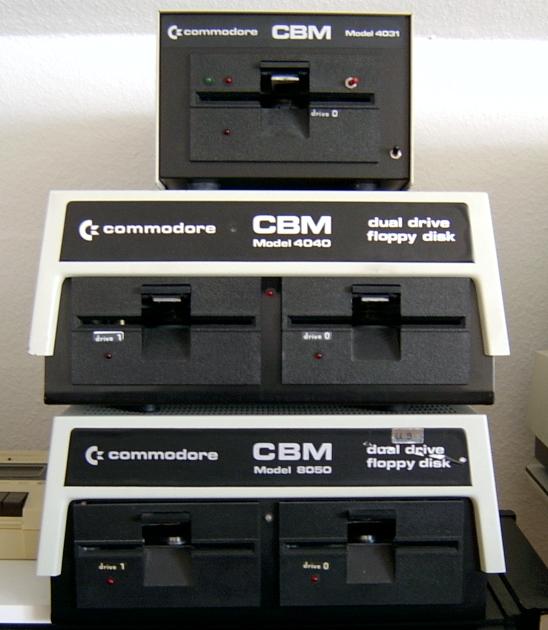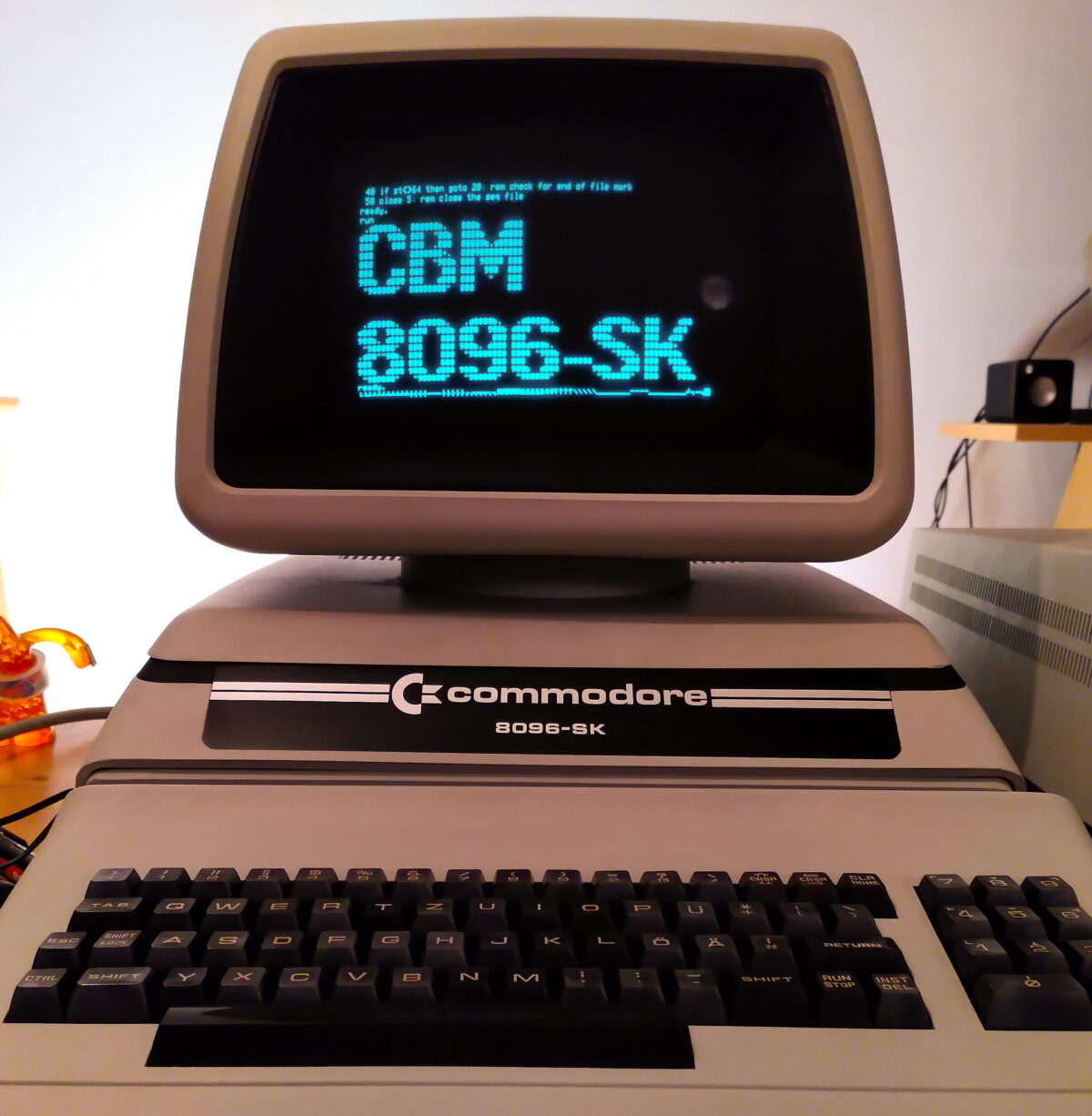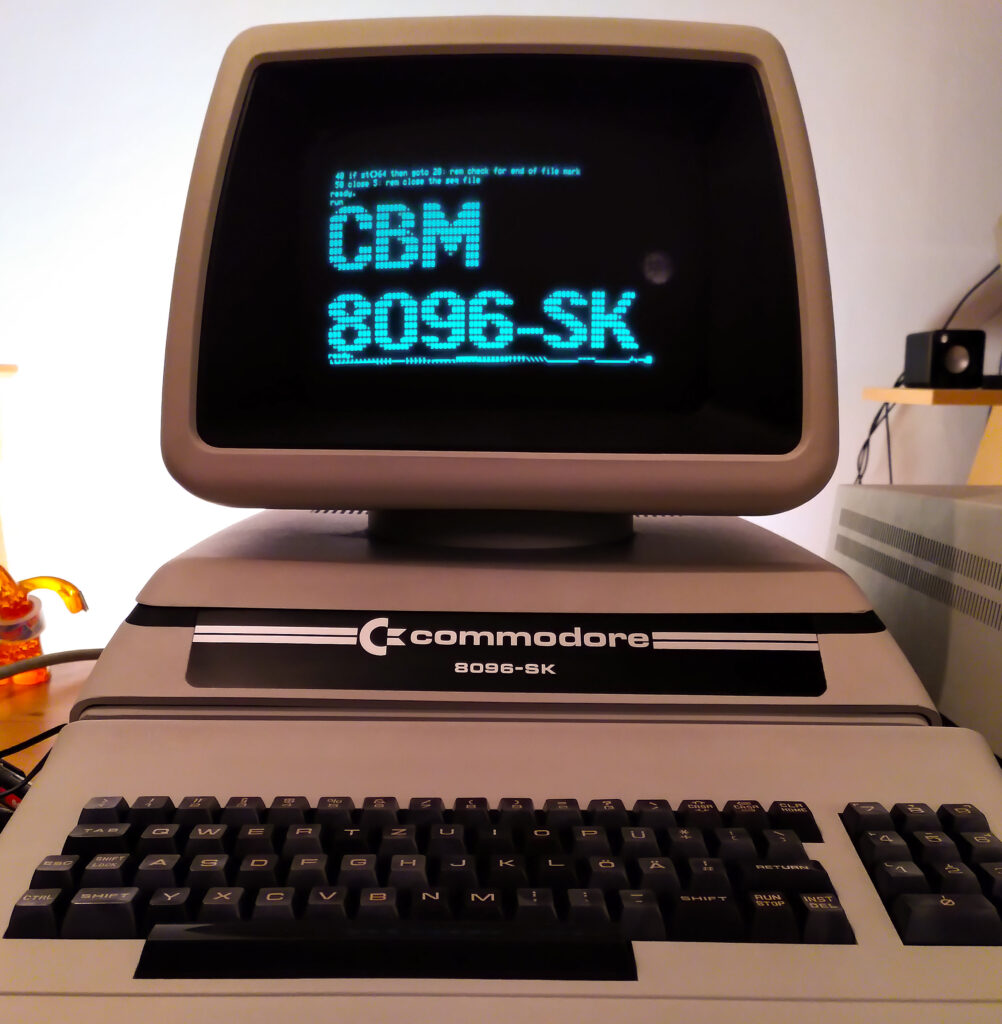For some time now, I can call myself the happy owner of a Commodore CBM 8096-SK. Before I introduce my own computer in more detail, I would like to give a brief overview of the Commodore PET and CBM series that were available during the 8-bit era from 1977 until around the mid-1980s. As it turns out, a brief summary is not that easy, as there were a sometimes confusing number of series and model variants. Nevertheless, I will try to give as concise an overview as possible.
In 1977, Commodore, alongside Apple and Tandy RadioShack, released its first fully-fledged micro-computer for the mass market based on the 8-bit processor 6502 with 1 MHz developed by Chuck Peddle at MOS Technologies. In the years that followed, this became a series of computers that were mainly suitable for serious office applications and for learning. However, they were also frequently used to control industrial systems and for scientific purposes.
Here I present a small overview of the very legendary model series.
2000 Series

The Commodore PET (Personal Electronic Transactor) of the 2000 series were the first all-in-one computer models marketed by Commodore from 1977 onwards. Legendary is the original PET 2001 with 9″ monochrome monitor, 4kB SRAM, MOS 6502 8-bit CPU, the so-called Mickey Mouse or chiclet keyboard and built-in datasette. The other model variants differed in the RAM equipment, the housing color (blue/white or black/white) and later in the type of keyboard. The computer did not have a separate graphics chip and could therefore only display alphanumeric characters and graphic symbols (PETSCII character set). It had several connections for extensions: User port, datasette and IEEE-488 bus for printers and floppy disk drives.
Apropos Keyboard
Incidentally, the abbreviation PET goes back to the father of the computer, Chuck Peddle, and creates a link to the English word pet. The computer was intended to be a faithful friend and feel at home in every household. Due to a naming rights dispute with Philips, the PETs had to be renamed in Europe and were henceforth known as CBM (Commodore Business Machines), which was also the official name of the company.

In Germany, there was a branch of Commodore Büromaschinen GmbH based in Neu-Isenburg near Frankfurt. Some of the CBM series were then also manufactured in Braunschweig and were very widely distributed in Germany. For example, around 100,000 of the later 8000 series were sold.

In subsequent series, Commodore also distinguished between two keyboard variants: The business keyboard had no graphic symbols printed on the keys and the character set supported upper and lower case letters. There was also the so-called “home computer” version of the keyboard with graphic symbols printed on the keys. The character set can be switched using a key combination.
3000 Series
The 3000 series came onto the market from 1978 and was the successor series to the 2000 series. They were technically largely identical to their predecessors, but now always had the better typewriter keyboard. The computers were again available with different RAM configurations (from 8 kB to 32 kB) and with a built-in 9″ monochrome monitor (40 characters/line x 25 lines). The motherboard was virtually identical to the 2000 series, but now used dynamic RAM chips instead of static ones. The CPU was still a 6502 MOS processor clocked at 1 MHz. The computers were delivered with Commodore BASIC V2 in ROM. Commodore BASIC was an extended Microsoft BASIC. Jack Tramiel, the head of Commodore, secured the rights to Microsoft BASIC and was thus able to use it under his own name and with extensions in his devices.

4000 Series
The successor series to the 2000 and 3000 models are the 4000 series computers. These devices are now equipped with the extended BASIC V4 and were available with two different monitor variants: As a so-called Thin model with the familiar 9″ monochrome monitor and as a Fat model with a 12″ monitor. As before, the housings were very robust metal chassis which, together with the keyboard and monitor, made the computer very heavy and massive. The well-known 6502 CPU with 1 MHz clock frequency was still used in the 4000 series. The RAM configuration now varied from 8 kB (4008) to 64 kB in the 4064 model. Otherwise, they hardly differed technically from their predecessors. However, the V4 BASIC now also supported more DOS commands for the use of floppy disk stations, among other things.
For models with a 12″ monitor, an 80 character card could also be installed as an extension.

8000 Series
Originally, the 8000 series was a 4000 series computer with a 12″ monitor and 80 character mode. This new series was available in three different housing designs: In addition to the familiar angular metal housing and integrated keyboard (CBM 8032), a completely redesigned housing was introduced with the 8000 series from around 1982.
In keeping with the new spirit of the times, Commodore chief designer Ira Velinsky designed a very futuristic new case for both the CBM and the CBM II series. Contrary to many rumors, the design was not created by Ferdinand Porsche, even if the elegant curves might suggest that. There was also a third model with a built-in double floppy drive (CBM 8296-D).
The computers of the 8000 series now had a monochrome screen with 80 characters/line as standard. However, the processor is still the MOS 6502 CPU with 1 MHz. What is new, however, is the removal of the 32kB RAM limit through the possibility of bank switching between the RAM areas and a new video section, which was equipped with its own video chip (6545) for the first time. Furthermore, the computers with the new housing shape now have a “detached” keyboard, which is connected to the computer via a spiral cable. In addition to BASIC V4, the LOS-96 operating system was also supplied on floppy disk from model 8096 onwards, as this was the only way to address the entire RAM. With the later model 8296, the mainboard was redesigned and was already equipped with 128 kB RAM.

Due to the lack of pixel graphics, the PETs were rather unsuitable for gaming. Nevertheless, there were a number of games with block graphics, at least for the 40-character PETs. However, these games are usually no longer compatible with the 8000 series. For this reason, there were programs that emulated a 40-character screen.
CBM II Series
With the new housing shape, Commodore introduced the CBM II series based on the new MOS 6509 processor, which was to be available as the CBM 500 with different features for private households (P) and as a business version (B). The new processor was an extended 6502, which could address up to 1 megabyte of RAM by using integrated bank switching.
The P version already had the VIC II graphics chip later known from the C64 and a SID sound chip. Due to the emerging price pressure for home computers, however, only very few of the P version were sold and Commodore pursued a different strategy for the home computer series.
The B variant, on the other hand, was sold for a few years with moderate success. The CBM 600 was a keyboard computer without a monitor. It also had a MOS 6509 8-bit CPU with 2 MHz, a 6581 sound chip (SID) and 128 kB RAM. It could also be equipped with an optional coprocessor (Zilog Z80 or Intel 8088). With the IEEE-488 bus and BASIC V4 also available, the available diskette stations could also be used with the CBM II family.

The CBM 700 series was again designed as an office computer including a monochrome monitor. It was very similar to the 8000 series in the new round housing (see CBM 8096-SK or 8256-SK). The top model CBM 730 was equipped with an impressive 256 kB RAM and Intel 8088 coprocessor with 4 MHz.

CBM Floppy Disk Station
With the exception of the very first 2000 series of PETs with cassette drive and the late models of the 8000 series with built-in floppy disk drive, a mass storage device always had to be purchased separately. The computers could all be expanded with both datasette and floppy disk drives. As the floppy disk stations were still very expensive at the time, the much cheaper datasette with standard cassettes was often used as the storage medium.
Over the course of time, Commodore developed several different floppy disk drive models with different features and capacities for the CBM series. As the computer itself does not have a floppy controller, this was integrated into the floppy disk station. The stations therefore always had their own processors for control and the DOS (Disk Operating System) is also integrated as a ROM module. The models differed in the drive mechanics used and the possible storage density for the floppy disks. The floppy disk drives were connected via the powerful, parallel IEEE-488 bus.

Detailed model list of all CBM/PET devices:
http://www.6502.org/users/andre/petindex/local/cbm-model-list.1.0.txt


